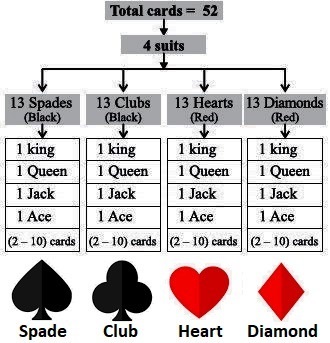Unit 13: Probability
Class 9 Mathematics | Punjab Curriculum and Textbook Board Syllabus 2025
1. Define probability.
Probability is the chance of a particular event occurring. It is calculated as:
$${Probability = \frac{Number\ of\ favourable\ outcomes}{Total\ number\ of\ possible\ outcomes}}$$
$$P(A) = \frac{n(A)}{n(S)}$$
Where:
- $P(A)$ is the probability of event A
- $n(A)$ is the number of favourable outcomes
- $n(S)$ is the total number of possible outcomes
2. Where does the word probability come from?
The term "probability" originates from the Latin word "Probabilitas", meaning "probity". The Italian physician and mathematician Girolamo Cardano is regarded as the father of probability theory.
3. Define experiment.
The process which generates results.
For example: tossing a coin, rolling a dice, etc. is called an experiment.
4. Define outcomes.
The results of an experiment are called outcomes.
For example:
- The possible outcomes of tossing a coin are head or tail
- The possible outcomes of rolling a dice are $1,\ 2,\ 3,\ 4,\ 5,$ or $6$
5. Define favourable outcome.
An outcome which represents how many times we expect the things to be happened.
For example:
- While tossing a coin, there is $1$ favourable outcome of getting head or tail
- While rolling a dice, there are $3$ favourable outcomes of getting multiples of $2$ i.e. $\left\{ 2,\ 4,\ 6 \right\}$
6. Define sample space.
The set of all possible outcomes of an experiment is called sample space. It is denoted by S.
For example:
- While tossing a coin, the sample space will be $S = \{ H,T\}$
- While rolling a dice, the sample space will be $S = \{ 1,2,3,4,5,6\}$
7. Define event.
The set of results of an experiment is called an event.
For example: while rolling a dice, getting even number is an event i.e.,
$$A = \left\{ 2,4,6 \right\};\ n(A) = 3\ \ \ \ \ \ \ (means\ 3\ favourable\ outcomes)$$
8. What are the different types of events in probability?
The types of events in probability are:
1. Certain event
An event which is sure to occur. Its probability is 1 (or 100%).
2. Impossible event
An event that cannot occur in any trial. Its probability is 0 (or 0%).
3. Likely event
An event that will probably occur. It has a greater chance, around 75%.
4. Unlikely event
An event that will probably not occur. It has a lesser chance, around 25%.
5. Equally likely events
Events that have equal chances of occurring. Their probability is 0.5 (or 50%).
Note: The range of probability for an event is: $0 \leq P(A) \leq 1$
9. What is the probability of an event not occurring (complement of an event)?
The probability of an event not occurring is called the complement of the event. It is written as $P\left( A' \right)$ or $P\left( A^{c} \right)$ and is calculated using the formula:
$$P\left( A' \right) = 1 - P(A)$$
For example: when tossing a coin:
- Let $A$ be the event of getting a head. Then, $P(A) = \frac{1}{2}$
- The event of not getting a head (i.e., getting a tail) is the complement, denoted as $A'$
$${P\left( A' \right) = 1 - P(A)}$$
$${P\left( A' \right) = 1 - \frac{1}{2}}$$
$${P\left( A' \right) = \frac{2 - 1}{2}}$$
$${P\left( A' \right) = \frac{1}{2}}$$
So, the probability of not getting a head is also $\frac{1}{2}$.
Note: The sum of the probability of an event and its complement is always:
$$P(A) + P\left( A' \right) = 1$$
For example: if the probability of $\mathbf{rain}$ today is $0.3$, then the probability of $\mathbf{no\ rain}$ is:
$$1 - 0.3 = 0.7$$
10. What Is a Deck of Cards?
A deck of cards has $52$ cards in total.
🔹 4 Types of Cards (Called Suits):
There are $4\ suits$ in the deck:
1. Spades (♠) — Black
2. Clubs (♣) — Black
3. Hearts (♥) — Red
4. Diamonds (♦) — Red
Each suit has $13\ cards$.

Distribution of suits and colors in a standard deck
What Cards Are in Each Suit?
Each suit has the same set of $13$ cards:
- $1$ Ace
- $9$ number cards (from $2$ to $10$)
- $3$ face cards:
- $1$ Jack
- $1$ Queen
- $1$ King
$$Total\ per\ suit = 1\ (Ace) + 9\ (numbers) + 3\ (face\ cards) = 13\ cards$$
🔴 Red Cards vs. Black Cards
$\mathbf{Red\ cards} = Hearts + Diamonds = 26\ cards$
$\mathbf{Black\ cards} = Spades + Clubs = 26\ cards$
🧠 Important Points to Remember
Total cards $= \mathbf{52}$
Each suit $= \mathbf{13\ cards}$
Total Aces $= \mathbf{4}$
Total Kings $= \mathbf{4}$
Total Queens $= \mathbf{4}$
Total Jacks $= \mathbf{4}$
Total face cards $= \mathbf{12}$ ($3$ from each suit)
12. Define Relative Frequency.
Relative frequency shows how often a specific event happens compared to the total number of events or trials.
It is calculated using this formula:
$${Relative\ Frequency = \frac{Frequency\ of\ specific\ event}{Total\ frequency}}$$
$$= \frac{x}{N}$$
Where:
- $x = frequency\ of\ the\ specific\ event$
- $N = \sum f = total\ of\ all\ frequencies$
Note:
- The sum of all the relative frequencies is always equal to or approximately equal to 1.
- Relative frequency is an estimated probability of an event occurring when an experiment is repeated a fixed number of times.
13. What is expected frequency?
Expected frequency is a measure that estimates how often an event should occur, based on its probability.
Expected frequency is calculated using the formula:
$$\text{Expected frequency} = \text{Total number of trials} \times \text{Probability of the event}$$
$$E = N \times P(A)$$
Note: Sum of all expected frequencies is always equal to or approximately equal to the total number of trials.